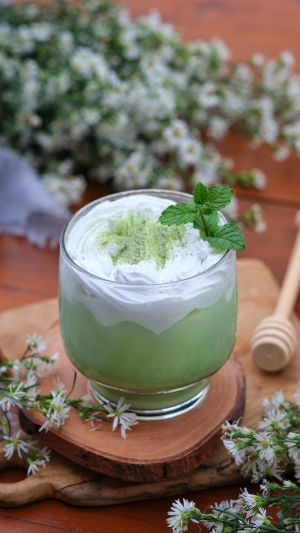A steaming hot, vivid green matcha latte on a cold winter day can instantly transport you back to spring.
The warmth radiates through the cup into your palms; wisps of steam rise slowly from the rim; the delicate aroma gradually awakens your senses; and the vibrant green color banishes the despair of winter.
As the warmth flows from your mouth down your throat to your stomach, the heat spreads to your limbs, driving away the chill and leaving only comfort and tranquility, instantly rejuvenating you.
From the first sip, the person was captivated by the rich and refreshing taste of matcha latte. With each stir, the slightly bitter yet refreshing tea aroma rushes into nostrils, as if transporting people to vast tea fields. You might ask, why doesn't drinking a latte feel like being in a coffee plantation?
"Why doesn't a matcha latte contain coffee? Do you even know how to make coffee?"
Dear, it's not that baristas don't know how to make coffee; it's just that matcha latte never contains a drop of coffee. It's essentially milk with matcha flavor.
Unlike our common milk tea, matcha latte is better described as "eating tea" rather than "drinking tea". Matcha undergoes grinding with a stone mill, preserving its color and flavor compounds, but the tea particles don't dissolve in water.
With each sip, along with the refreshing tea and milk aroma creating a wonderful taste, you can also feel the ultra-fine tea particles dancing in your mouth, which is a unique way of consuming matcha. The refreshing scent of matcha combined with the creamy milk has attracted many fans.
<h3>So, what is a latte coffee then?</h3>
A latte coffee is the classic blend of Italian espresso and milk. Italians also love to have lattes as their breakfast beverage.
When Italians drink lattes, it's not so much about their love for Italian espresso as it is for milk. Italian espresso is brewed by forcing hot water through finely ground coffee powder under high pressure. By adding an equal proportion of milk to this strong and rich Italian espresso, you create a latte coffee.
Nowadays, many cafes offer beverages like matcha lattes, red tea lattes, pumpkin lattes, red velvet lattes, and many others, none of which contain any coffee. There are also many popular lattes in Korean cafes like five-grain lattes.
<h3>How to make a matcha latte:</h3>
To create a rich and creamy foam, whisk high-quality matcha powder and pour it into steamed milk. That's your matcha latte!
If you want to make a matcha latte coffee, here's the recipe:
1. Pour half a cup of milk into a stainless steel cup and add an appropriate amount of matcha powder. Stir well.
2. Froth the milk. You can use steam frothing or a handheld electric frother. When using an electric frother, heat the milk to about 65 degrees Celsius for better frothing results and stability.
3. Pour the frothed matcha milk into a coffee cup. High-quality matcha powder can create a rich and delicate foam when poured into the milk.
4. Sprinkle some matcha powder on top for decoration.
Whether you're enjoying a classic latte coffee or savoring the delicate nuances of a matcha latte, may each sip remind you of the simple pleasures found in a cup of warmth and the beauty of a shared experience? So next time you take a moment to sip on your favorite beverage, may it not just be a drink, but a journey to cherish and savor.





